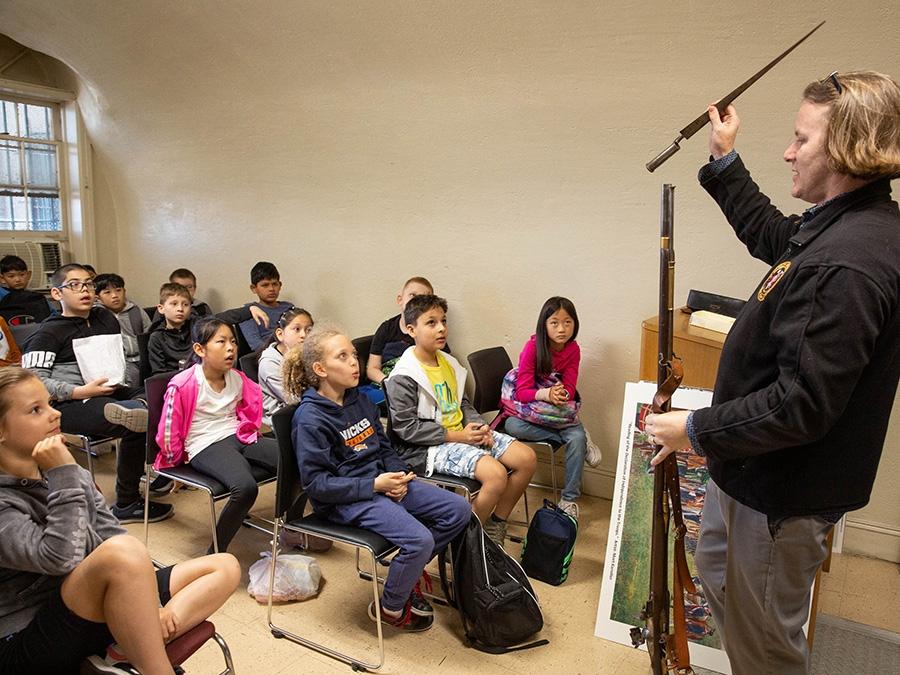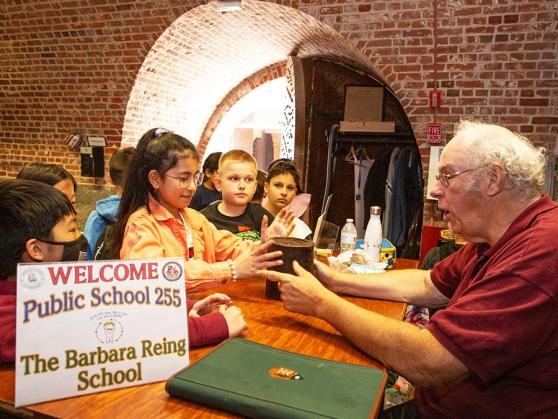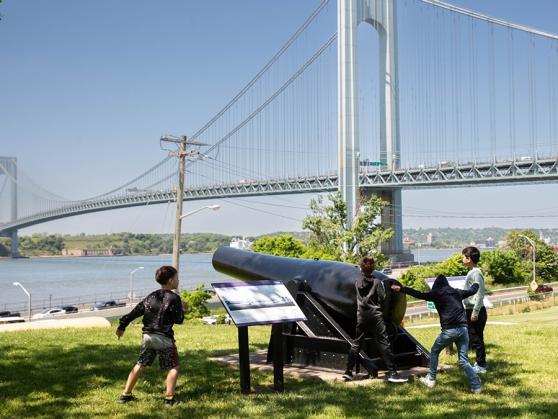‘Revolutionary’ learning experience

Fourth-graders from PS 255 in Brooklyn are riveted as Harbor Defense Museum Director Justin M. Batt shows them a musket and a bayonet fragment while speaking about the Revolutionary War.

Museum docent Kevin Hanley shows the 4th-graders a canister shot replica filled with ammunition and asks if they are able to lift it.

During their lunch break, PS 255 students pretend they’re firing at boats passing through the Verrazzano Narrows.
One of the first things docent Kevin Hanley asked the 4th-graders from PS 255 in Sheepshead Bay to do when they entered the Harbor Defense Museum at Fort Hamilton in southwest Brooklyn was to say, “cluck, cluck.”
“Now I can officially welcome you to the chicken coop,” he said, using the English translation for caponnière, a French word that was modified to “caponier” to describe a defensive structure within a fortification. Fort Hamilton’s caponier — which was once surrounded by a dry ditch — protected the rear of the fort from an infantry-led attack.
The 43-year-old museum, located in part of the garrison’s original masonry fort, is home to collections of weaponry, armaments, actual and replica uniforms, photos and other memorabilia from the American Revolution to World War II. The Harbor Defense Museum, one of 29 U.S. Army museums nationwide, documents the history of Fort Hamilton and seacoast defense in New York.
The fort was built on part of the landing site of the British invasion of New York in 1776. It overlooks the Narrows, the tidal strait separating Brooklyn and Staten Island that serves as the maritime “gateway” to New York City. The fort, which opened in 1831, was located there to protect the city from naval attack.
“The Army would build these forts like Fort Hamilton very close to the water, arm them with cannons and if any ships would come by, we would protect it,” museum director Justin M. Batt told the PS 255 students during their May visit.
But no enemy ever tried. “So, we did a good job,” he said. “We scared them.”
The 90-minute class trip consisted of two parts: a tour of the museum’s collections in the caponier and a classroom program on the Revolutionary War that included a musket demonstration in another part of what remains of the old fort.
The visit was timely for the 4th-graders, who had recently learned about the Revolutionary War and the post-war era in New York State. The war’s largest fight — the Battle of Brooklyn in 1776 — is particularly relevant to her students because it happened in their own backyard, teacher Samantha Bonowicz said.
“Our curriculum is based on a lot of the New York battles, so it’s helpful to connect those ideas that they’ve already learned,” she said.
Because of the COVID-19 pandemic, a lot of the students on the trip had never been to a museum before, she noted.
In the 200-year-old building that houses the museum, the students marveled at a Civil War-era Howitzer cannon and a mannequin of an artilleryman pointing a gun out of an opening in the masonry wall. Hanley pulled out a canister shot replica and asked the students to try lifting the projectile — filled with 40 pounds of ammunition — that would have traveled a short distance and sprayed metal balls.
In the classroom part of the visit, 4th-grader Amir, who sat in the front row, had a chance to hold a musket that Batt brought out as he talked to the children about the Revolutionary War. He also showed students a bayonet fragment from the same period.
“I’m never going to wash my hands again,” Amir said.
Teacher Andrea Scuotto said the PS 255 teachers appreciated that Batt also talked about other elements of U.S. history their students had studied, including the Boston Tea Party and the Quartering Act that required colonists to house British soldiers.
The 176-acre property remains an active Army base, Batt said, with housing, activities, amenities and resources for soldiers and their families that include a fitness center, a bowling alley, a pool, a barber shop and stores.
“We’re our own little town,” he said.
He pointed out that the soldiers at the base today have different missions, such as working with the city’s police and fire departments and at local airports.
The visit ended with the children eating their packed lunches on the bluff that overlooks the Narrows and the Verrazzano-Narrows Bridge. Some students gravitated to a defunct Rodman cannon that faces the water. They took turns pretending to shoot a passing barge and other ships, shouting “Three-two-one fire!” again and again.
The Harbor Defense Museum is open by appointment from 10 a.m. to 4 p.m., Tuesdays through Fridays. Class trips are free. The museum offers a tour of the museum along with a structured classroom program that can be tailored for various grade levels. Its classroom programs primarily focus on the development of harbor defenses in the New York City area and/or the Battle of Brooklyn. For more information, email justin [dot] m [dot] batt [dot] civ [at] mail [dot] mil (justin[dot]m[dot]batt[dot]civ[at]mail[dot]mil) or call 718-630-4349.